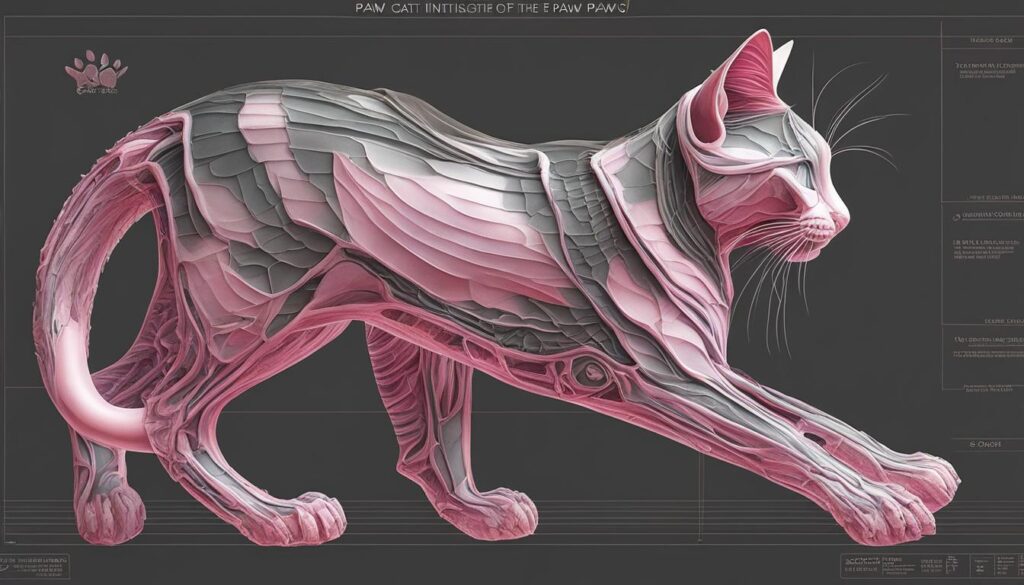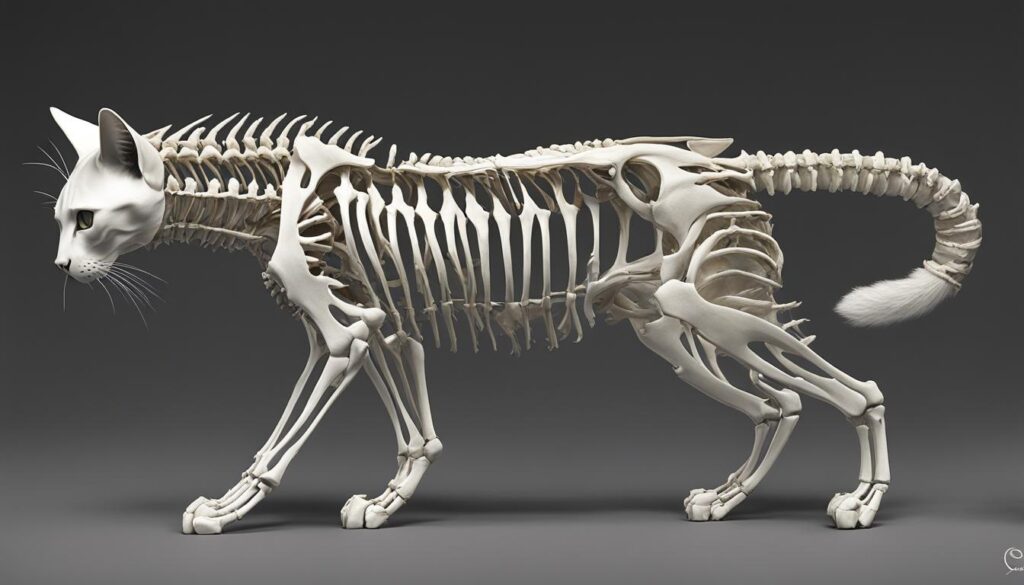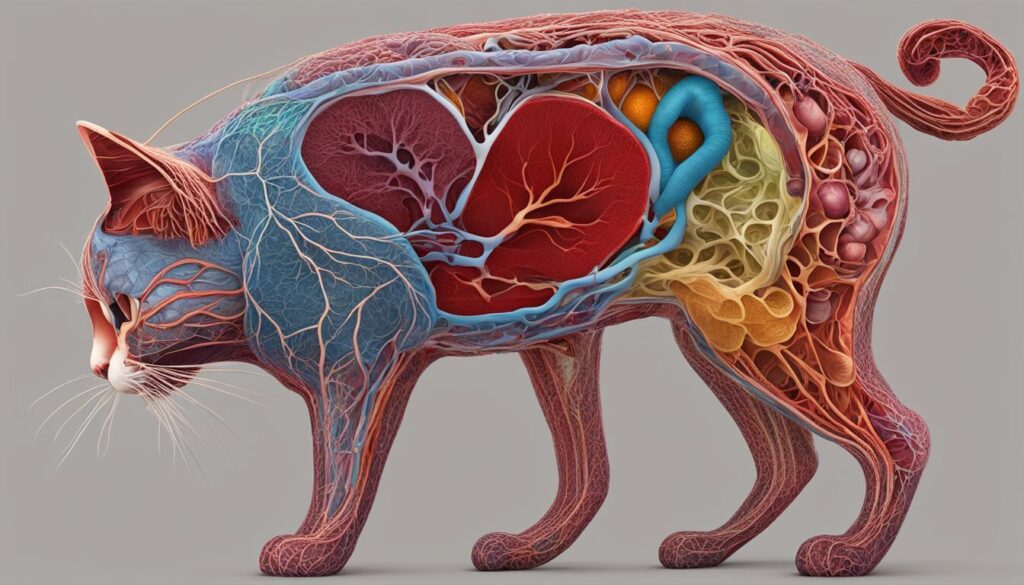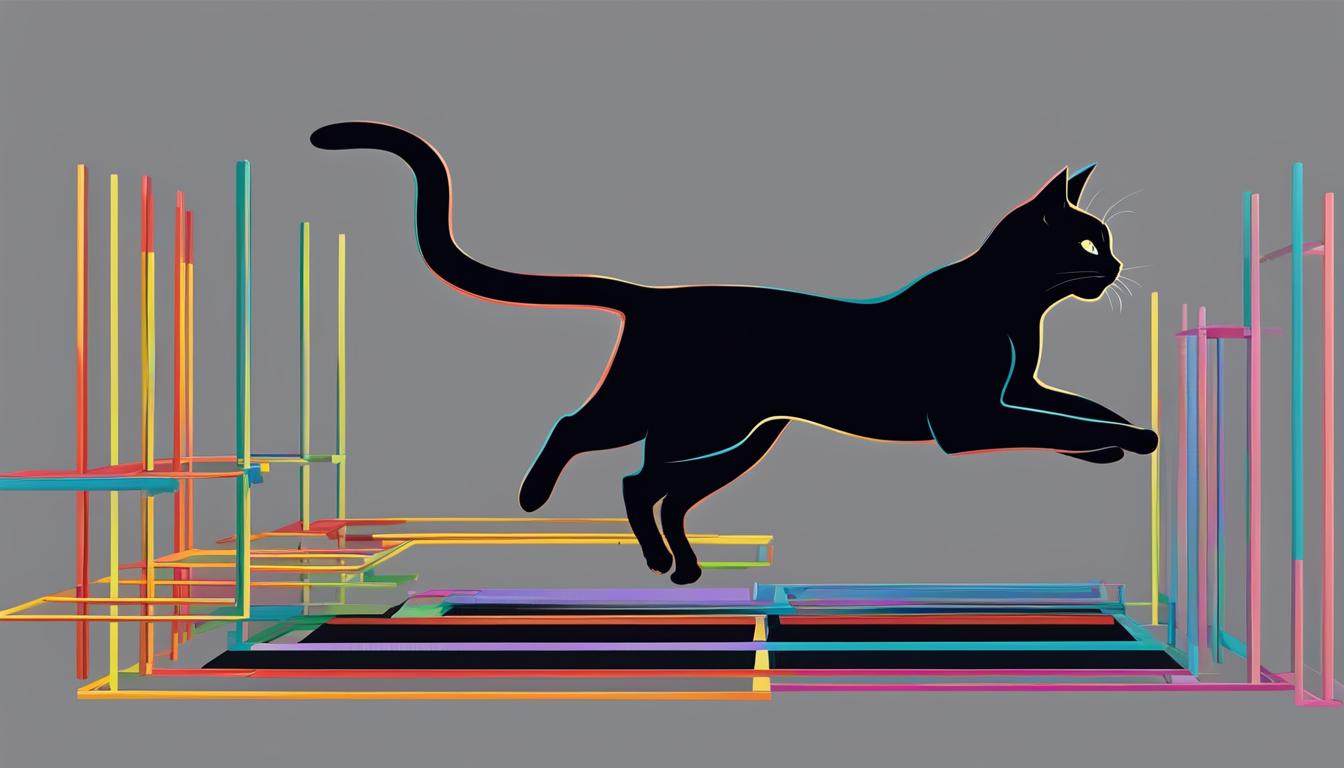Hey there, fellow cat enthusiasts! Are you ready to embark on a fascinating journey into the intricate world of cat anatomy? Join me as we unravel the mysteries behind our feline friends’ physical structure and gain a deeper understanding of their remarkable abilities.
Cats are more than just cute and cuddly companions. They possess a complex anatomy that deserves our attention and appreciation. By delving into the details of cat anatomy, we can unlock a world of knowledge that will not only help us care for our furry friends but also strengthen our bond with them.
Key Takeaways:
- Understanding your cat’s anatomy can help you take better care of them.
- Cats have highly developed senses, including sharp eyesight and acute hearing.
- Their paw anatomy serves various functions, from balance to climbing.
- A cat’s unique skeletal structure enables their agility and flexibility.
- Exploring their internal systems can help monitor their overall health.
The Fascinating World of Cat Senses
Cats possess an array of highly developed senses that contribute to their remarkable abilities and behaviors. Understanding how these senses work can provide valuable insights into your feline friend’s perception of the world. Let’s take a closer look at the different senses that make cats such fascinating creatures.
Cat Whiskers
Cat whiskers, also known as vibrissae, play a crucial role in a cat’s sensory perception. These specialized hairs are located on their face, chin, and even on the back of their front legs. Acting as delicate antennae, whiskers help cats navigate their surroundings by sensing changes in the environment. They are incredibly sensitive and can detect even the slightest air movements, allowing cats to determine if they can fit through tight spaces or to gauge distances before making leaps or pounces. Whiskers are also an essential communication tool, as they can convey a cat’s mood and intentions to other felines.
Cat Eyes
When it comes to feline senses, cat eyes are truly captivating. Their large size, vertical pupils, and reflective layer called the tapetum lucidum give them exceptional night vision. Cats have a higher number of rods, which are photoreceptor cells that work well in low light conditions, making them adept nocturnal hunters. Additionally, their eyes have a wide field of view, allowing them to monitor their surroundings for potential prey or threats. The mesmerizing colors of a cat’s eyes can vary, ranging from green and yellow to blue and even heterochromia, where each eye has a different color.
Cat Ears
Cat ears are not just adorable, they’re also incredibly versatile. With an impressive range of motion, cats can rotate their ears up to 180 degrees, independently of each other. This flexibility enables them to effectively locate and pinpoint the source of sounds, making them skilled hunters. Cats have highly sensitive hearing, capable of detecting high-frequency sounds that humans cannot perceive. They can pick up even the faintest rustle of leaves or the softest chirping of a bird, making their ears finely tuned instruments for survival and communication.
Cat Nose and Tongue
A cat’s sense of smell is extraordinary, thanks to the millions of olfactory receptors in their nose. Their remarkable ability to detect scents allows them to navigate their environment, locate prey, and even recognize familiar individuals. Additionally, cats have a unique organ called the vomeronasal organ, also known as the Jacobson’s organ. Located in the roof of their mouth, this organ detects pheromones and helps cats communicate with other felines. Along with their sense of smell, a cat’s tongue is also fascinating. Covered in tiny, backward-facing papillae, a cat’s tongue is designed to groom their fur efficiently and remove any debris, contributing to their impeccable self-care habits.
As we dive into the captivating world of cat senses, we gain a deeper appreciation for their unique abilities and understand the crucial role these senses play in their daily lives. From their precise whiskers to their enchanting eyes, ears, nose, and tongue, cats are truly sensory marvels that continue to captivate and charm us.
| Sense | Function |
|---|---|
| Cat Whiskers | Help cats sense changes in the environment, navigate tight spaces, and communicate with other felines. |
| Cat Eyes | Provide superior night vision, a wide field of view, and the ability to detect subtle movements. |
| Cat Ears | Have a remarkable range of motion, allowing cats to locate the source of sounds and detect high-frequency sounds imperceptible to humans. |
| Cat Nose | Contains millions of olfactory receptors, enabling cats to detect scents and navigate their environment. |
| Cat Tongue | Equipped with backward-facing papillae for efficient grooming and debris removal. |
Unraveling the Mysteries of Cat Paw Anatomy
When it comes to our feline friends, their paws are more than just adorable little bundles of fur. Cat paw anatomy is a fascinating aspect of their physical structure and plays a crucial role in their daily activities. Let’s take a closer look at the intricate details of cat paws and how they contribute to a cat’s overall functionality.
Cat paws are equipped with an array of features that make them incredibly versatile. First and foremost, their paw pads act as shock absorbers, providing cushioning and stability as they walk, run, and jump. These padded surfaces also offer excellent traction, allowing cats to navigate various terrains with ease.
One of the most prominent features of a cat’s paw is, of course, its retractable claws. These sharp weapons are not only essential for self-defense but also serve several other purposes. Cats use their claws for climbing trees, hunting prey, and marking their territory by leaving scratch marks on surfaces. The ability to retract their claws when not in use helps keep them sharp and protected from wear and tear.
| Paw Functions | Explanation |
|---|---|
| Balance | Each paw is equipped with specialized nerve receptors that enable cats to maintain their balance, making them excellent acrobats and allowing them to land gracefully on their feet. |
| Grooming | Cats use their paws to groom themselves, licking their fur and then running their paws through it to remove dirt, debris, and loose hair. |
| Scent Marking | By scratching certain objects or surfaces, cats leave behind pheromones from their paw pads, effectively marking their territory. |
In addition to these functions, cats also sweat through their paws. While they don’t rely on sweating to regulate body temperature like humans do, their paw sweat glands help cool them down in hot weather. So the next time you see your cat with slightly damp paws, know that it’s just their way of beating the heat!

Now that we’ve unraveled some of the mysteries of cat paw anatomy, we can truly appreciate the complexity of these adorable appendages. From balance and grooming to scent marking and cooling down, cat paws are truly remarkable in their functionality. So the next time you see your furry friend extending their claws or padding around the house, take a moment to marvel at the wonders of their paws!
The Unique Skeleton of Cats
Cats have a truly remarkable skeletal structure that sets them apart from other animals. Their bones are specifically designed to support their incredible agility and flexibility. Let’s take a closer look at the fascinating anatomy of a cat’s skeleton.
Bones and Structure
The average cat has around 250 bones, each contributing to their remarkable physical abilities. These bones can be categorized into three main groups: appendicular, axial, and splanchnic. The appendicular skeleton consists of the bones of the limbs, giving cats the ability to climb, jump, and pounce with precision. The axial skeleton includes the skull, backbone, and ribs, providing stability and protection for vital organs. Lastly, the splanchnic skeleton comprises the bones in the tail, tail base, and the “sternum” — the breastbone.
Landing on Their Feet
One of the most incredible aspects of a cat’s skeleton is its ability to always land on its feet. Cats possess a flexible backbone with 30 vertebrae, which allows them to twist and turn their bodies mid-air to ensure a graceful landing. Additionally, they have no collarbone, enabling their front and hind legs to move independently, further enhancing their agility.
| Bone Type | Description |
|---|---|
| Long Bones | Found in the limbs and contribute to movement and support. |
| Short Bones | Located in the paws and provide stability and flexibility. |
| Sesamoid Bones | Small, pea-shaped bones found in the joints of the limbs, promoting smooth movement. |
| Flat Bones | Contribute to the protection of vital organs, such as the skull and ribs. |
| Irregular Bones | Have unique shapes and can be found in various parts of the skeleton, such as the vertebrae. |
The Remarkable Cat Skeleton
The skeleton of a cat is an intricate and finely tuned structure that enables them to perform impressive physical feats. From their ability to always land on their feet to their agile climbing and hunting skills, the unique skeletal anatomy of cats is truly a marvel of nature.

The Unique Internal Systems of Cats
As we explore the fascinating world of cat anatomy, it’s essential to delve into the internal systems that keep these magnificent creatures up and running. Cats have a well-developed cardiovascular system that ensures the efficient delivery of oxygen and nutrients throughout their bodies. Combined with their unique digestive system, which is adapted for a meat-based diet, these internal systems play a crucial role in a cat’s overall health and well-being.

The Cat Cardiovascular System
The cat’s cardiovascular system is responsible for supplying oxygen and nutrients to all the vital organs and tissues. It consists of the heart, blood vessels, and blood circulation. The feline heart is a muscular organ that pumps oxygen-rich blood to the body and deoxygenated blood to the lungs. With a rapid heart rate, cats have a higher metabolic rate compared to humans. This efficient cardiovascular system enables them to sustain their active and agile lifestyles.
The cat’s blood vessels comprise arteries, veins, and capillaries that transport blood throughout the body. Arteries carry oxygenated blood away from the heart, while veins bring deoxygenated blood back to the heart. Capillaries, the smallest blood vessels, facilitate the exchange of oxygen, nutrients, and waste products between the blood and the body’s tissues.
The Cat Digestive System
The cat’s digestive system is specialized for processing a meat-based diet. Like their wild ancestors, domestic cats are obligate carnivores, meaning they require animal protein to thrive. Their digestive tract is relatively short, optimized for efficiently digesting and absorbing nutrients from animal-based food sources. The cat’s digestive system includes the mouth, esophagus, stomach, small intestine, large intestine, and rectum. It also features specialized structures, such as sharp teeth for tearing meat and a powerful stomach acid that aids in the breakdown of proteins.
The small intestine is where most nutrient absorption occurs, while the large intestine is responsible for the final stages of the digestion process and the elimination of waste. Cats also have a unique digestive adaptation known as the “hindgut fermentation,” which allows them to extract essential nutrients from plant-based materials in small quantities.
Understanding Your Cat’s Internal Systems
By understanding how the cat’s cardiovascular and digestive systems function, you can better monitor your furry friend’s health and provide appropriate care. Regular check-ups with a veterinarian, a balanced and nutritious diet, and sufficient hydration are crucial for maintaining your cat’s internal systems in optimal condition. When it comes to your cat’s heart and gut, knowledge is power in ensuring their overall well-being and longevity.
Developmental Stages in Kittens
Watching kittens grow and develop is a fascinating journey filled with adorable milestones. From their birth to the eighth week, kittens undergo significant changes and reach important developmental stages. Understanding these stages can help you provide the best care and support for your growing feline friend.
Kitten Development Phases:
- Week 1: Kittens are born blind and deaf, relying on their sense of touch and smell to locate their mother and nurse.
- Week 2: Their eyes begin to open, revealing the captivating world around them. They start to develop their sense of sight and their hearing begins to emerge.
- Week 3: By this time, kittens’ eyes are fully open, and their vision and hearing become more refined. They start to wobble around on unsteady legs, attempting to explore their surroundings.
- Week 4: At this stage, kittens start to show more coordination and balance. They begin to experiment with solid food, although they still rely on their mother’s milk for nutrition.
- Week 5: Their baby teeth start to come in, and they become more playful and energetic. They enjoy socializing and interacting with their littermates and humans.
- Week 6-8: By this time, kittens are fully weaned from their mother’s milk and transition to a diet of solid food. They continue to develop their physical skills, coordination, and social behaviors.

Observing and taking part in the growth of kittens is a rewarding experience. By understanding the different developmental stages, you can ensure their healthy growth, provide appropriate stimulation, and create a nurturing environment that supports their emotional and physical well-being.
Conclusion
So there you have it – a complete guide to cat anatomy that will leave you feline knowledgeable and ready to decode the mysteries of your furry friend. Whether you’re studying cat biology or simply want to deepen your understanding, this cat anatomy study guide is a purrfect resource.
From the fascinating world of cat senses to unraveling the secrets of cat paw anatomy, we’ve covered it all. You now know how those adorable whiskers help them sense vibrations, how their eyes are tailor-made for hunting in the dark, and how their sensitive paws serve multiple functions.
But we didn’t stop there! We also explored the unique skeleton of cats that enables their agility and flexibility, and delved into the internal systems that keep them healthy and thriving. And let’s not forget about the important developmental stages in kittens – from blind and deaf newborns to playful and curious little explorers.
Whether you’re looking for a cat biology study guide or educational resources for cat dissection, you’ve come to the right place. So, go ahead and put your newfound knowledge to use. Observe your feline companion with a discerning eye, appreciate their incredible anatomy, and cherish the special bond you share.
FAQ
What are the main topics covered in this cat anatomy guide?
This guide covers the different aspects of a cat’s physical structure, including their skeletal system, muscular system, internal organs, and unique sensory abilities. It also explores the developmental stages in kittens.
How do cat senses contribute to their navigation in the environment?
Cat senses, such as their whiskers, eyes, ears, and sense of smell, help them detect vibrations, see in low light, hear sounds from all directions, and communicate with other cats.
What functions do cat paws serve?
Cat paws are highly sensitive and help cats maintain balance, climb, grasp objects, and regulate their body temperature. They also contain nerve receptors that enable them to feel vibrations.
What makes a cat’s skeletal structure unique?
Cats have a flexible backbone with 30 vertebrae, no collarbone, and a large number of bones that provide them with agility and flexibility. Their skeletal system enables them to always land on their feet.
What internal systems are crucial for a cat’s health?
The cardiovascular system ensures the delivery of oxygen and nutrients to different parts of the body, while the digestive system helps cats process and metabolize a meat-based diet efficiently.
What are the developmental stages in kittens?
Kittens go through significant growth and development from birth to 8 weeks of age, including the gradual development of their senses, the opening of their eyes and ears, and the growth of their teeth.





